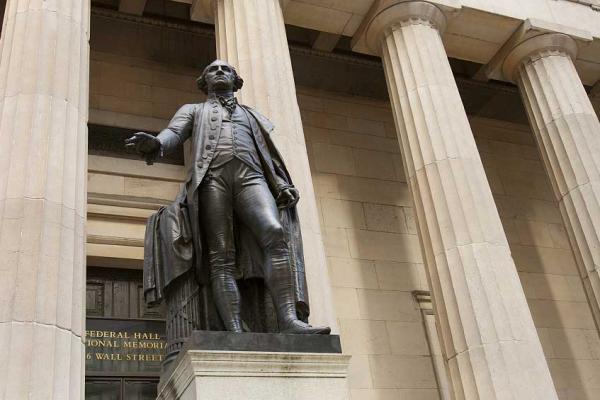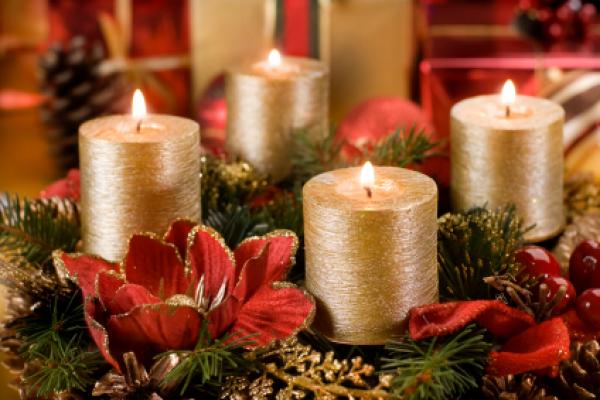Inauguration Day occurs in the USA once every four years on January 20. It occurs in the year after presidential elections have been held. The new terms of office of the president and vice-president officially begin at noon in Washington DC.
 George Washington was the first person to be inaugurated as president of the USA.
George Washington was the first person to be inaugurated as president of the USA.
©iStockphoto.com/Kohlerphoto
What do people do?
On Inauguration Day the candidates, who won the elections in the previous year, are sworn into office as president and vice-president of the United States. The swearing-in ceremony takes place at the U.S. Capitol and is organized by the Joint Congressional Committee on Inaugural Ceremonies. It is usually followed by a parade along Pennsylvania Avenue.
The new president watches the parade from the presidential viewing stand in front of the White House. The route of the parade is often lined by thousands of people. However, many Americans watch the ceremony on television or listen to it on the radio.
Public life
Inauguration Day is not a public holiday and many people are expected to work as usual. Many schools, stores and other organizations are open as normal in many parts of the USA. Public transport services run on their regular schedules. There may be changes to normal broadcasting schedules on television and radio, as news stations cover the inauguration ceremony.
Inauguration Day is a federal holiday for some federal employees who work in the District of Columbia or the surrounding areas. This is mainly to reduce the amount of congestion on the roads and public transit systems of the area.
In and around Washington DC there can be considerable disruption to public life, both on Inauguration Day and in the days before and after the ceremony. This is not only due to the actual ceremony and parades that accompany it, but also the protests and demonstrations that are organized and the massive security operation that takes place. If you have business affairs in this area in the second half of January in an inauguration year, it is wise to check carefully that you will be able to do what you need to.
Background
The head of state of the USA has been a president since 1789. In that year, George Washington was elected and inaugurated as president of the United States of America. He was inaugurated for the first time on April 30, 1789, and for the second time on March 4, 1793. Subsequent inaugurations were held on March 4 until the second inauguration of President Franklin Roosevelt on January 20, 1937. Since then Inauguration Day has been held on January 20 and the term of office officially starts at 12:00 noon on that date.
Usually the vice-president is sworn in first and the president at exactly 12:00 noon. After they have been sworn in, the president and vice-president are given four ruffles and flourishes. The ruffles are played on drums and the flourishes on bugles, which are simple brass instruments with no valves. The ruffles and flourishes form a fanfare before performance of the president’s anthem, “Hail to the Chief”, and the vice-president’s anthem, “Hail, Columbia”. There is then a 21-gun salute from the howitzers of the military district of Washington.
After the ceremony, the president and vice-president are guests of honor at a luncheon given by the United States Congress. Later in the day, they parade down Pennsylvania Avenue and walk part of the way from the Capitol to the White House. If Inauguration Day falls on is a Sunday, the presidential oath is usually administered in a private ceremony on that day and a public ceremony and celebrations are held on the following day.
On January 20, 2009, Barack Obama will be the first African American president to be inaugurated. The results from the USA election, which was held on November 4 in 2008, determined that Obama would be the next president to lead the nation.
Courtesy of TimeandDate.com
The Advent season marks the beginning of the Christian year across many western churches in the United States. Its length varies from 22 to 28 days, starting on the Sunday nearest St Andrew’s Day and encompassing the next three Sundays, ending on Christmas Day.
 Advent wreaths can be seem in some churches in the United States during the Advent season.
Advent wreaths can be seem in some churches in the United States during the Advent season.
©iStockphoto.com/Dušan Zidar
What do people do?
Many Christians in the United States attend a church service on the first Sunday of Advent and may engage in activities such as special prayers and contributing to ideas on enhancing peace. Many Advent traditions are observed in the United States in the prelude to Christmas Day. For example, the Advent wreath is becoming increasingly popular in the United States. The wreath can be seen in various churches across the nation around this time of the year.
Advent calendars of all designs are also given as gifts at this time of the year. The calendars feature openings in the form of windows or doors that are numbered to count the days to Christmas. Calendars may contain chocolates, toys, or candy and are given to children as a fun way to observe the Christmas countdown. Some traditional Advent calendars show 24 days but many Advent calendars showing 25 days, with the last opening on Christmas Day.
The church year begins in September 1 in many eastern Christian churches, so Advent begins at a different time to when it starts in the western churches. The eastern equivalent of Advent is called the Nativity Fast, which runs for 40 days.
Public life
The first Sunday of Advent is not a nationwide public holiday in the United States. However, churches may be busy on this day, as well as families who use the beginning of Advent as a time to prepare for the Christmas season.
Background
It is uncertain as to when exactly the celebration of Advent was first introduced in the Christian church. Some sources say that Advent began on November 11 (St Martin’s Day) at some time in the fifth century in the form of a six-week fast leading to Christmas. Advent was reduced to its current length at some stage in the sixth century and the fasting was later no longer observed. Advent is originally a time to reflect and prepare for Christmas similarly to how Lent is in preparation for Easter. Advent has sometimes been referred to as the Winter Lent. In recent times the restrictions that Advent brings to Christians have become more relaxed.
Advent traditions spread from Europe to the United States, especially the Advent calendar, which became very popular in the United States after World War II as American military personnel and their families who were stationed in Germany brought them home and made them a part of the pre-Christmas traditions. Some people credit President Dwight Eisenhower with helping the tradition of the Advent calendar spread in the United States during the 1950s.
Symbols
Purple is historically the main color used for Advent because it reflects penitence, fasting, and the color of royalty to welcome the Advent of the king (Jesus Christ). The focus of the entire season is the celebration of the birth of Jesus the Christ in his first Advent, and the anticipation of the return of Christ the King in his second Advent. Some churches use other colors in recent times. For example, some churches mark the third Sunday of Advent with pink or rose, colors that represent joy. Many Protestant churches use blue to distinguish the Season of Advent from Lent.
Advent wreaths are symbolic of Advent. They are usually made of fir and decorated with gold and silver ribbons or scarlet woolen threads. Lit wreaths may be displayed on the table where family and friends sit while singing carols and preparing handmade gifts.
About First Sunday of Advent in other countries
Read more about First Sunday of Advent.
Courtesy of DateandTime.com
